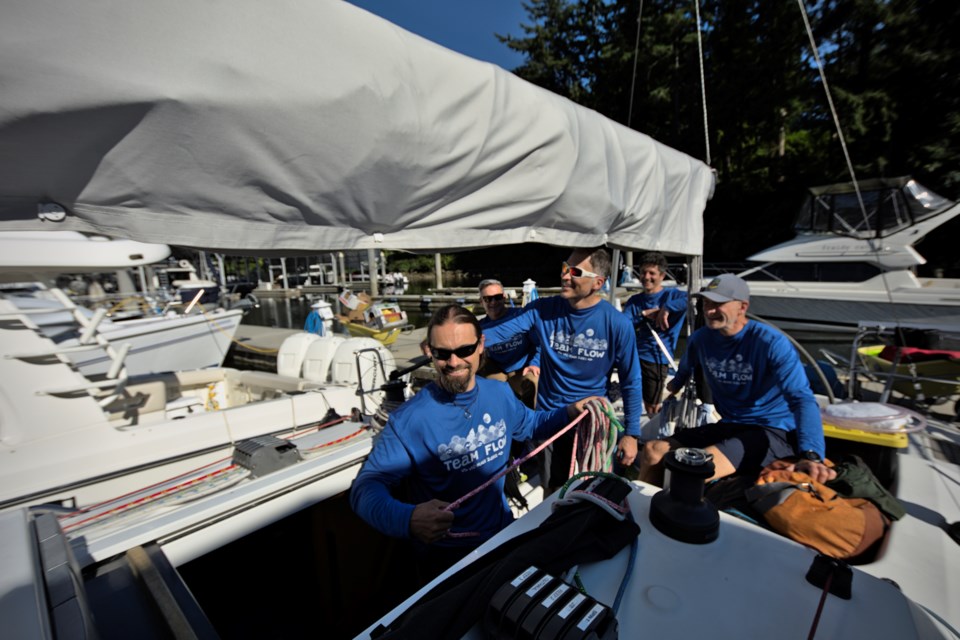A sailing team stacked with doctors and professors is set to run a tight ship on its 4,275-kilometre race across the Pacific, so long as the crew isn’t three sheets to the wind.
Last Friday (July 1), sailing vessel Flow left its home port of Thunderbird Marina in West Vancouver on its way to the starting line in Victoria. The Vic-Maui International Yacht Race officially started on Monday, and as of Wednesday the ship was heading down the coast of Washington towards Oregon.
On board are skipper Dr. Stuart Horak, Dr. Sean Staniforth and Dr. Martin Roos, who all work at Lions Gate Hospital; Daniel O’Brien, a partner at PricewaterhouseCoopers who also lives on the North Shore; as well as UBC physics professor Andrea Damascelli and UBC electrical engineering professor Lukas Chrostowski.
On Flow, a 36-foot Dehler yacht, the brainy bunch will sail 2,308 nautical miles, crossing three time zones deep into open ocean. The team anticipates the trip to take 16 days, but it could be as short as 14 or as long as 18.
Despite being the shortest – and therefore slowest – of the 12 boats in the race, the crew is going for gold. The results are determined by a sophisticated handicap system based on a predicted maximum speed each boat should go, which means Flow has a fighting chance.
Working in the crew’s favour are previous sailing experiences together, and strong friendships. In 2019, Flow and most of its current crew competed in VanIsle 360, placing second in its division in a 14-day race around Vancouver Island. More recently, in May, Flow placed second overall in the three-day PNW Offshore race from Ilwaco, Wash., to Victoria.
Working against the crew are dangers of being at sea, and the rum ration.
A host of mechanical issues can go wrong on the boat, and there’s no shop to take it to. So you have to anticipate what can go wrong, and have lots of spaces, explained Roos.
“One of the most common things that can fail on a boat is the steering can go out,” he said. “So there's a completely separate backup steering, a whole other rudder.”
The boat carries an angle grinder on board, with a diamond blade that can be used to cut through heavy-duty rigging that can snag on the steering under the boat if the mast goes down.
Sudden weather events will happen, and they’ll have to jump into action to get the sails down. Occasionally, hurricanes will come up from the Baja Peninsula – which happened during the race in 2016 – so the crew will be keeping an eye to the weather to steer clear of those. They’ll also have to avoid other open ocean obstacles like shipping containers and whales.
'Sails, food, water and rum'
To be as nimble as possible, creature comforts have been cut to the bare minimum. Normally, cruising boats are lined with cosy cushions.
“All that's been hauled off and stripped down,” Roos continued. “We've replaced it with vomit-proof boards.”
Only the essentials remain: “Basically, it's going to be sails, food, water and rum," said Skipper Horak with a chuckle, reminding Roos that they’ll need the ship's electronics in addition to the sailor’s tot.
While the crew isn’t allowed any outside help to navigate, they’ll be able to access publicly available information like government websites and weather reports – using a snail’s pace satellite connection. They also have to make daily contact with the race committee.
Only Damascelli has sailed the route previously, but several crew members have expert yachting qualification.
Many of them are good friends too, so Horak said mutiny is unlikely. “If we have one strength, I think that as a crew we should all get along really well,” he said, adding that a few of them do regular ski trips together.
Regardless of the race's outcome, the crew’s families are meeting them in Hawaii for a week-long holiday with sailors from the other ships. “That’s kind of the reward in some ways,” Horak said.
If you want to follow the Flow’s progress, you can watch the race live on the Vic-Maui website, or the team’s Facebook page.




